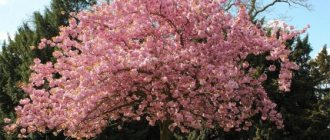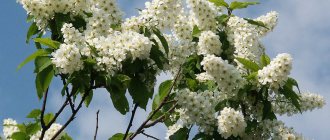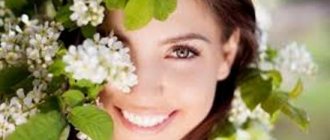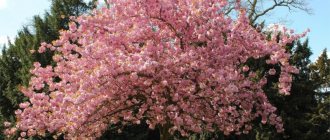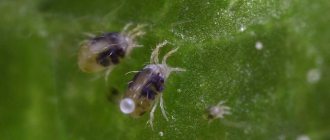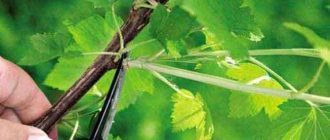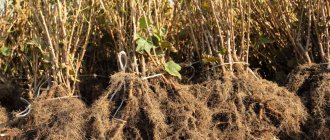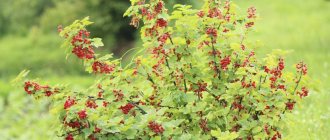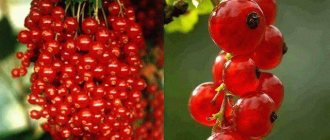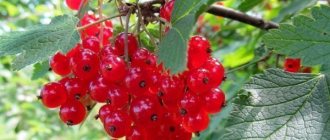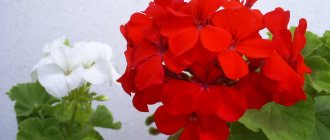Hello everyone friends.
The American plant red bird cherry is very useful. Contains many vitamins and tannins. Used to treat women's diseases, throat, bronchitis and other common cases.
This charming tree comes from America, more precisely from Virginia. Therefore, the correct name for the red-fruited plant is Virginia bird cherry. It differs from ordinary cherries not only in the color of the fruits, but also in the leaves - they also turn bright red in the fall.
It blooms in late spring, and after a couple of months you can taste the first fruits. It grows mainly in America, but you can find it in southern Russia, the Caucasus, and other areas.
True, unlike American trees, which are “wild” plants, bird cherry trees with red fruits in Russia are planted in home gardens by amateur gardeners. And for good reason - it is not only beautiful, but also useful.
Vitamin and mineral composition of berries
To understand whether red bird cherry is healthy, it is worth considering its vitamin and mineral composition.
The fruits contain:
- Vitamin C is an immunostimulant, increases the body’s resistance to viruses and bacteria, accelerates the healing process of colds;
- Vitamin P - belongs to flavonoids, normalizes blood pressure, regulates heart rate, stimulates the activity of the adrenal cortex;
- magnesium - ensures the normal functioning of the nervous system, prevents surges in blood sugar levels, helps muscles recover faster after exercise;
- iron - participates in supplying body tissues with oxygen necessary for normal growth of the body, supports the functioning of the thyroid gland, improves brain function;
- cobalt - participates in protein metabolism, is necessary for DNA synthesis, stimulates the growth and development of red blood cells, improves blood composition;
- copper - necessary for the conversion of iron into hemoglobin, destroys free radicals, participates in the formation of energy, stimulates the immune system;
- zinc - improves metabolism, maintains the sharpness of taste and smell, is necessary for bone growth;
- manganese - regulates blood glucose levels, normalizes the functioning of the nervous system and brain, and is necessary for the growth of connective tissue.
It will not be superfluous to find out what active substances are contained in the fruits. Some substances present in bird cherry determine not only its beneficial properties, but also contraindications for use.
Bird cherry contains:
- amygdalin is a glycoside, in the human body it turns into poisonous hydrocyanic acid, dangerous to health, found in the bones and bark of bird cherry;
- tannins - have an astringent effect, eliminate bleeding gums, reduce the likelihood of internal bleeding, normalize stool during diarrhea;
- antioxidants - reduce the harmful effects of free radicals on the body, prevent the development of cancer;
- anthocyanins - give the fruit a bright red hue, have sedative, bactericidal, immunostimulating properties, increase visual acuity, protect against stress, improve sleep, are not able to accumulate in the body, so their reserves must be constantly replenished;
- chlorogenic acid - has fat-compressing properties, improves metabolism, regulates appetite, normalizes intestinal motility, prevents the formation of blood clots;
- caffeic acid - has anti-inflammatory and immunomodulatory effects, protects against cancer;
- feluric acid - has anti-allergic and anti-inflammatory properties, increases the absorption of vitamin E, protects the skin from the harmful effects of sunlight;
- volatile - have an antibacterial effect, destroy viruses and fungi;
- dietary fiber - improves digestion, normalizes intestinal function, establishes bowel movements and makes them regular, and normalizes blood sugar levels.
Anthocyanins
Anthocyanins (7.57%) contained in red bird cherry are several times higher than other plant sources. Therefore, the plant is an excellent source of biologically active polyphenols, consisting of glycosides, which are included in many drugs.
A feature of anthocyanins is the lack of synthesis in the human body. They are quickly destroyed and do not accumulate in the body, so they must be constantly supplied with food. The daily requirement of a healthy person is 200 mg, and a person suffering from diseases is 300 mg.
Anthocyanins contained in red bird cherry strengthen vision.
Anthocyanins are known for their antioxidant, sedative, bactericidal and strengthening properties. Therefore, they are used in complex treatment and prevention:
- cold;
- viral and bacterial infections;
- cardiovascular failure;
- ophthalmological pathologies;
- neuropathy, stress, insomnia;
- atherosclerosis;
- exhaustion of the body after chemotherapy;
- cleansing the body of toxins.
Anthocyanins are part of many dietary supplements to improve vision. Studies have shown that people who regularly take active polyphenols have sharper vision.
Chlorogenic acid
Chlorogenic acid (355.3 mg) is not common in nature; it is mainly found in green coffee beans, and when roasted, it loses an impressive part of its beneficial properties. This acid is primarily known for its fat-burning properties, which are widely used by manufacturers of weight loss products. In addition, the substance has regulatory, restorative and antioxidant properties.
Cherries contain chlorogenic acid, which has fat-burning properties.
Benefits for the body:
- reduction in sugar;
- suppression of the synthesis of “bad” cholesterol;
- normalization of intestinal function;
- removing toxins from the body;
- metabolic acceleration;
- prevention of blood clots;
- burning fat by regulating glucose synthesis.
Caffeic acid
Caffeic acid (181.1 mg) has a carcinogenic effect, inhibiting the development of cancer cells.
Feluric acid
Feluric acid (194.3 mg) is known for its antiallergic, anti-inflammatory, sunscreen properties and additionally increases the bioavailability of vitamin E. This substance is often used in cosmetology and has anti-aging, protective and brightening skin care products.
Interesting Facts
You can tell a lot of interesting things about bird cherry; there are many legends and parables in which the bird cherry tree appears. Among the Japanese, Sakura is one of the main characters in many stories. We present the most remarkable facts about her:
- Archaeological excavations have shown that berries have been known to man since the Stone Age. It is not known exactly what was prepared from them.
- Bird cherry is widespread not only in Russia and the USA, but throughout the world. The plant is cultivated wherever there is a temperate climate.
- A wide variety of baked goods can be made from bird cherry flour, including the famous Siberian cake.
- Crafts are made from wood - bird cherry wood is characterized by hardness and elasticity, which makes it an excellent material.
- A synthetic analogue of flowers is used in the army and serves as the basis for the production of a poisonous concentrate.
- At the same time, it was bird cherry juice that was used as a remedy during the Great Patriotic War. It was used to treat wounds.
- Hydrocyanic acid, which is part of bird cherry blossoms, has increased volatility. This is why branches should not be carried into the house. Even though they are beautiful, they are dangerous for humans and animals.
So we learned all the features of bird cherry. Of course, a lot more can be said about her, because she has become known to the world since ancient times. In Rus', bird cherry was called “swarthy”; the ancient Greeks learned about it thanks to Theophrastus; all over the world it is considered a symbol of love and youth. Interestingly, according to one legend, a girl who could not tolerate betrayal turned to the bird cherry tree, her heart froze, and therefore the flowering of the tree coincides with the cold snap. By the way, this is where the folk superstition comes from, which says that the onset of winter can be determined by the bird cherry blossoms.
And to learn how to quickly make bird cherry jam, watch a simple video recipe. It will help make a delicious treat for everyone!
Tannins
Tannins (1%) from red bird cherry fruits have P-vitamin properties. This is a pronounced anti-inflammatory effect on the intestinal mucosa, regulation of the secretory function of the gastrointestinal tract.
As a result, intestinal motility improves and the rate of absorption of products increases. Tannins have a bacteriostatic (growth-inhibiting) effect on many microorganisms and absorb toxins.
Red bird cherry berries contain tannins.
Benefits for the body:
- elimination of dysentery, dysbacteriosis;
- cleaning from radioactive elements;
- regulation of the digestive tract;
- prevention of radiation sickness, bleeding;
- elimination of poisoning by plant poisons and salts of heavy metals.
Tannins are destroyed when frozen and quickly bind to the proteins of other products before they reach the intestinal mucosa. Therefore, in order not to damage the fruits of red bird cherry, they are consumed fresh and on an empty stomach.
Red currant fruits are contraindicated for use in acute pathologies of the gastrointestinal tract, increased acidity of the body and in the presence of individual intolerance to the components.
This is a potential allergen that should not be used if the immune system is hypersensitive. Excessive consumption of fruits in the body provokes intestinal obstruction.
The benefits and harms of bird cherry
Red bird cherry has both beneficial properties and contraindications for use. The medicinal properties of bird cherry were known and still sought after by the indigenous peoples of North America.
By studying the chemical composition of the plant, scientists were convinced that red fruits have a rich composition, containing:
- vitamins;
- essential oils;
- potassium;
- polysaccharides;
- acids;
- tannins.
A higher percentage of polysaccharides and a lower amount of tannins compared to black bird cherry make bird cherry fruits more tasty: sweet and not tart.
The leaves and fruits of the plant are used for disinfection, and are also used as decoctions for treating premises.
In addition, bird cherry has the following beneficial properties:
- improves heart function;
- normalizes the functioning of blood vessels;
- has a beneficial effect on the urinary system.
Harm from consuming berries, leaves and bark of red bird cherry can occur if an abnormal amount is used. Hydrocyanic acid, which is found in all parts of the bush, including berries, can lead to poisoning.
When consuming large quantities of any part of the plant, the amount of hydrocyanic acid consumed also increases. Excessive consumption of fresh shoots and leaves is also dangerous for livestock.
Red bird cherry is an original plant that does not require painstaking care. Beautiful during flowering and fruiting, this shrub can become the highlight of your garden plot.
Virgin bird cherry: description and beneficial properties, methods of reproduction, care
Red bird cherry is native to North America.
A very beautiful, abundantly flowering plant can be grown as a multi-stemmed bush or small tree. It all depends on the method of pruning the main shoot. Bird cherry fruits are not only beautiful, but also very beneficial for the body.
Description of the plant
Red bird cherry begins to bloom later than usual. Therefore, flowers are not damaged by spring frosts, and this contributes to the highest yield. Flowering is abundant, beautiful, lasts about 14 days. The flowers are white, small, two-fingered. They do not emit odor.
Fruit ripening also occurs later than in ordinary bird cherry. In August or early September, bright or dark red fruits appear. The taste is pleasant, sweet and sour, less tart than the ordinary one. The tree bears fruit regularly. The fruits do not fall off for a long time and can decorate the tree even in winter until next spring.
The composition of the fruit includes sugar, organic acids and tannins . They are consumed fresh, dried, frozen and added to compotes. The seeds contain oil. They are used to prepare bird cherry flour, which, in turn, is used to prepare the filling for baked goods. In addition, the berries are consumed fresh and added to compotes.
Healing properties of fruits
Virgin bird cherry contains a storehouse of vitamins, antioxidants and minerals. It is enriched with beneficial compounds that have a positive effect on the human body and even treat many diseases, including colds. Bird cherry has the following effects on the body:
- improves digestion, relieves stomach upsets;
- increases sweating, which is very effective in treating colds;
- has antibacterial and anti-inflammatory effects;
- strengthens the walls of blood vessels;
- cleanses the blood, removing toxins and lowering bad cholesterol levels;
- prevents the appearance of cancer;
- has a diuretic effect;
- heals joints by removing heavy metal salts;
- increases immunity.
Apple varieties: characteristics and yield of trees
Despite all these beneficial properties, red bird cherry still has contraindications. The consumption of its fruits is contraindicated for pregnant women due to the content of hydrocyanic acid in their composition. This element is harmful to the development of the fetus.
In other cases, Virginia bird cherry will bring both taste and benefit, unless a person experiences individual intolerance to its composition.
Caring for virgin bird cherry
Bird cherry is not capricious and does not require special care. However, it prefers to grow on loose and fertile soils, which must be well moistened. Therefore, in its natural environment, the tree can often be found near river banks. It should be located in a spacious and sunny area. Bird cherry drains the soil well. Main advantages:
- drought resistance;
- frost resistance;
- does not attract pests;
- not susceptible to disease.
Main features of care:
- When planting ready-grown seedlings, it is necessary to dig a large hole so that the entire root system can freely fit in it. In order for the plant to take root more easily, mineral fertilizers should be added to the hole.
- Abundant watering is important only immediately after planting. In this case, the soil should be saturated with water at a level of 25–30 cm. During the entire period of growth, the tree is flooded about 3 times.
- It is recommended to place bird cherry trees at a distance of more than 2 m from other trees due to overgrowth. Alone, bird cherry will not be able to pollinate. Experts advise planting it close to other species. Then, as a result of cross-pollination, they will produce new hybrid varieties with mixed traits.
- In order for the tree to be lush and the first branches to grow as low as possible, the seedling should be pruned by 50 cm immediately after planting. Subsequently, you need to prune the main trunk during the growth period to form a shrub. If this is not done, the plant will grow in the form of a tree. The way the bird cherry tree looks will depend on the pruning method.
- It is necessary that nothing prevents the penetration of air to the roots. To do this, you need to weed the soil to remove weeds and loosen it.
- In the spring, after fertilizing, you should thoroughly loosen the soil by 60 cm so that the fertilizer penetrates deeper.
- In order for the bird cherry to bloom profusely and produce a good harvest, it is necessary to trim the side branches. At the same time, the crown is trimmed and formed, depending on what the result is: a tree or a shrub. The optimal plant height is considered to be 3 m.
- Every 3 years, organic fertilizers, such as manure, are added to a depth of 10−15 cm. This should be done in moderation. In this case, the rule “the more the better” does not apply.
Although the tree loves sunlight, it can also grow in partial shade. But in this case the harvest will be less. There is no need to remove fallen leaves, as they mulch the soil well, having a beneficial effect on its composition.
Planting methods
Plant propagation is carried out in several ways. It is difficult to plant seeds, and the process of sprouting takes a long time. And the first fruiting will begin no earlier than in 6-7 years. Place the seed at a depth of 6 cm in the prepared soil. This must be done in the fall.
Apple tree “Simirenko”: botanical description, planting, care
If there is a desire to plant in the spring, then a process of stratification or seed preparation . To do this, they are placed in containers with soil and put in the refrigerator for a while, thereby simulating winter natural conditions. This preparation takes approximately 3-4 months. As a result of this process, the seeds take root and grow better.
https://www.youtube.com/watch?v=JUeZwEgrSH4
When choosing a cutting method, it is recommended to use green cuttings. They are cut into 15 cm lengths after the shoots have stopped growing. All leaves, except 2-3 at the very top, must be removed.
Then the cuttings are soaked for one day in a solution that stimulates growth. But you can also use ordinary water.
The next day after soaking, the cuttings should be planted in prepared nutrient soil to a depth of 3 cm.
It is important to cover the seedlings with film , thus creating greenhouse conditions. In this case they will give good roots. Immediately after the roots appear, the cuttings are ready for planting in open ground. It is normal if the seedling grows slowly at first.
To improve the situation, it is fed with mineral fertilizers and provided with regular watering.
Another equally effective method of propagation is considered to be root shoots . This is the simplest method. In the spring, part of the root system is separated from the main tree, and in the fall it is planted in open prepared soil.
But propagation by layering requires special care. Layers must be buried in holes 10 cm deep, placed around the main plant. They should be secured with wooden stakes.
Layers must often be spudded and fed. The difficulty lies in separating the cuttings from the mother tree. This is done in the fall after sufficient rooting.
After this, they are seated in the place where the Virginia bird cherry will grow.
Planting and caring for the plant is not very difficult. You just need to carefully handle the planting material and maintain favorable conditions for the plant.
Norway maple: description, tree care rules
Source: https://nasotke.pro/derevya/uhod-za-cheremuhoj-virginskoj
Bird cherry collection
It is important to understand that only what is obtained in environmentally friendly places can be used as medicinal raw materials.
Flowers and wood are air dried in a shaded place. Berries are dried only fresh. A fruit dehydrator is ideal, but you can make do with an oven (50 C).
The shelf life of berries and bark is 5 years, flowers and leaves are 1 year in a dry place.
Bird cherry wood is light brown-red in color, polishes well, and is used to make useful items such as wooden boxes and tool handles.
How to prepare a medicinal decoction and tincture
A decoction of the berries, leaves or bark of bird cherry preserves almost all the healing properties of this crop. To prepare a decoction, you can use a mixture of different parts of the plant or take them separately.
Berries for medicinal use are collected during July-August. A decoction of them is prepared in a ratio of 1:10. For each glass of fresh berries, take 10 glasses of boiling water. Prepare the decoction over low heat for no longer than 20 minutes, then leave for at least another 2 hours.
To prepare an alcohol tincture you will need 50 g of bird cherry bark and a glass of vodka. After infusion for 2-3 weeks, the product can be used to disinfect wounds and to rub sore joints and back. To treat stomach disorders, it is good to drink tincture of bird cherry berries. This medicine is prepared from 150 g of berries and 500 ml of vodka, infused for 2 weeks. The finished product is taken for digestive disorders, 5 drops three times a day before meals.
What are the benefits of red bird cherry?
Since ancient times, red bird cherry fruits have been widely used in folk medicine for the treatment and prevention of various diseases. The rich chemical composition of the plant makes it useful for women, men, children and the elderly.
For men
For men, red bird cherry acts as a powerful aphrodisiac. The rich chemical composition and beneficial properties help accelerate peripheral blood supply and increase potency. Positively affects libido.
Among other things, red bird cherry helps cure trichomoniasis.
The calming effect of bird cherry tea will help men maintain a healthy nervous system during times of stress and overwork.
For women
Since ancient times, women have taken decoctions of red bird cherry as a natural contraceptive.
- For infectious diseases of the genital organs, women, in addition to the main treatment, are recommended to douche with a decoction of red cherries.
- The healing plant is commonly used for cosmetic purposes.
- To combat acne, rub problem areas with fruit juice.
- For dermatitis, drink 60 ml of bark decoction 30 minutes before meals.
- To ease the condition of the skin during tanning, wipe it with an alcohol tincture of dried flowers.
- A tincture of 1 tbsp will help in the fight against wrinkles and dry skin. l flowers are filled with hot water. After cooling in the tincture, moisten the cotton swab and wipe your face with it.
- Berry masks help strengthen hair and nails.
For children
Freshly squeezed juice from red bird cherry fruits has many beneficial properties, helping children with diarrhea, nausea, vomiting and dysentery. It has an astringent effect on the gastrointestinal tract, promotes the removal of harmful substances in case of poisoning and intoxication.
Attention! The berries should not be consumed by children under 3 years of age. When used for medical purposes, consult a pediatrician.
Problems of teenage skin, such as inflammation of the sebaceous glands, are also treated with red bird cherry juice. To do this, you need to wipe your face in the mornings and evenings for a month.
For the elderly
Beneficial properties of red bird cherry for older people:
- help lower cholesterol levels;
- strengthen the walls of blood vessels;
- help normalize blood pressure;
- Tea made from leaves and roots has a calming effect;
- Alcohol infusion of red bird cherry helps to cope with joint pain.
Is red bird cherry allowed for pregnant women?
In ancient times, healers used bird cherry as a remedy for unwanted pregnancy. It is believed that the berry can increase the activity of the uterus and thereby provoke a miscarriage. Therefore, bird cherry during pregnancy is considered a dangerous berry, especially in the early stages.
In addition, red bird cherry has a strengthening effect on stool. Due to hormonal changes in the body and the effect of progesterone on intestinal tone, expectant mothers already have difficulties with bowel movements. Bird cherry during pregnancy can aggravate the problem of constipation.
Another argument against consuming berries is the risk of allergic reactions to red fruits. Bird cherry contains anthocyanins, which can cause allergies.
The only acceptable use of bird cherry during pregnancy is the external treatment of skin diseases, conjunctivitis, and stomatitis. With a decoction of leaves, berries and flowers, you can wash wounds, wipe your eyes, rinse your mouth without swallowing the product. Do not eat berries or drink drinks containing bird cherry.
general characteristics
Bird cherry is a deciduous, fast-growing tree from the rose family that can reach 8-15 m in height. Blooms in May, bears fruit from July to August. Bird cherry berries are small (the size of a pea), usually astringent-sweet. Hidden inside each fruit is an inedible, bitter seed. But not only is it bitter, it also has toxic properties.
Content:
- general characteristics
- Beneficial features
- Use in folk medicine
- How to prepare correctly
- How to prepare a medicinal decoction and tincture
- Warning
- What else is useful
This tree is very common in Europe, Northern Asia and North Africa. Within Europe, bird cherry grows from the northern part of Scandinavia, starting from the shores of the Arctic Ocean, and all the way to Italy, Spain and Portugal. Although, it must be said, in the coastal region of the Mediterranean and in the west of France, you most likely will not be able to see bird cherry. But this tree with its delicate aroma pleases the inhabitants of Ireland, England, Croatia, Bulgaria, the northern part of Russia, the Caucasus, Western Siberia and even the Himalayas. This culture is also found in North America, in particular in Alaska and in some northeastern regions of the USA and eastern Canada. Bird cherry's favorite places are the banks of streams, wet forests, usually with alkaline soil, although the culture can often be seen on the acidic soils of mountainous regions.
And although the most famous is the common bird cherry, there are many other varieties of this crop, each of which also has certain advantages. For example, white bird cherry is an excellent “raw material” for honey. By the way, this type of honey is known as an excellent source of iron, manganese, zinc, copper, cobalt, vitamins C, and. Bird cherry is used in folk medicine to treat the respiratory system. Red bird cherry, which has anti-inflammatory and bactericidal properties, is no less useful. The berries of this variety are considered useful for treating the digestive organs, as well as bronchitis.
Indications for use
Unlike other plants, bird cherry has a number of contraindications due to the presence in its composition of the glycoside amygdalin, which, when broken down, forms hydrocyanic acid, which is harmful to health. So, drugs based on it are contraindicated:
- people prone to allergies to plant components;
- people prone to constipation;
- children under 2 years of age;
- people with type 2 diabetes.
Bird cherry has long been noticed in the culinary art. Basically, specific parts of the plant are used in folk medicine, but culinary preferences are given to its fruits.
Most often they are used to prepare juices, compotes, liqueurs, canned food, and snacks.
Fresh and canned fruits are used in the preparation of cakes, pies and rolls. Dried and collected fruits for the winter are used as an aromatic component of flour intended for baking bakery products.
Like any herbal medicine used in treatment, bird cherry has some contraindications for use.
- pregnancy and breastfeeding;
- children under 2 years of age;
- chronic constipation and the presence of hemorrhoids.
Attention. When eating bird cherry fruits, it is necessary to observe a certain measure. Too many berries consumed at one time can cause constipation in a healthy person.
Bird cherry is a real storehouse of useful substances. Perfectly helps in the fight against various ailments, as well as in the general strengthening of the body. But in order not to harm yourself, it is necessary to observe certain measures when using it, then the healing power of this plant will only benefit the body.
- Dysentery.
- Stomach diseases. Gastroenteritis (acute and chronic course).
- Rheumatism, arthritis, gout.
- Migraine, headaches.
- Increased temperature. Fever.
- Diarrhea.
- Inflammation of the small and large intestine.
- Painful symptoms due to joint diseases.
- Toothache. Caries.
- Heart disease.
- Furunculosis, dermatosis, purulent wounds, bedsores.
- Psoriasis, scabies, acne.
- Koch's wand.
- Conjunctivitis, blepharitis.
- Colpitis, venereal diseases.
- Toxicosis.
Like all medicines, preparations that contain bird cherry also have limitations in use and require serious consideration.
Bird cherry is a poisonous plant because it contains amygdalin, which is found in all parts of the tree. The breakdown product of this substance is hydrocyanic acid. That is why berry preparations are prepared from whole dried fruits.
Bird cherry berries have a strong adhesive property, which can lead to constipation. It is also a contraceptive - therefore, it affects the reproductive function of the female body.
Use by pregnant women is contraindicated, as there is a risk of miscarriage in the first trimester. The aroma of flowers can have a negative impact on the posture process. It is recommended to temporarily avoid bouquets of cherry flowers in the house.
It is not recommended to give berries to small children. Unripe fruits can cause poisoning.
Important! During long-term storage of medicines, poison is released from the berries and bark - hydrocyanic acid. Long-term storage is hazardous to health.
Care rules - watering, fertilizing, pruning
Caring for bird cherry does not involve any additional procedures other than the basic ones, such as: watering, loosening the soil in the tree trunk circle, removing weeds from the planting site, seasonal pruning treatments, and applying fertilizers. Moreover, even these activities are carried out depending on the age of the plants. For example, mature bushes require less moisture and are not afraid of weed growth, and young seedlings do not need annual pruning.
Adult bird cherry trees are watered approximately once every 10 days in dry weather and 2 times a month in normal weather conditions. If the summer turns out to be rainy, the precipitation may be completely sufficient for the development of the plant, and then watering should be avoided.
In order to reliably protect the crop from attack by pests and the occurrence of various types of diseases, every spring it is important to spray the plantings with a Karbofos solution. It will protect it from aphids, hawthorn, weevils and other parasitic insects. The drug is used in accordance with the instructions from the manufacturer.
There are also a number of diseases against which Korbofos is powerless. Knowing the symptoms of each ailment, you can eliminate the problem at the initial stage of its occurrence:
- Cytoporosis - affects wood and contributes to its drying out. The main sign of the presence of this fungus is the formation of white color on the surface of the bark. In the fight against cytoporosis, Bordeaux mixture and copper sulfate solution have proven themselves well. Trees are sprayed with these products in the spring for prevention or during the season when lesions are detected.
- Polypores are fungi that cause wood rot. To save the bird cherry, you need to immediately cut off all diseased parts of the tree and treat the damaged areas with a fungicide.
Infected plant fragments must be burned to prevent the disease from developing in the garden.
Pruning – formative and sanitary
Every year in spring, sanitary pruning of trees and shrubs is carried out in the garden. It involves removing plant fragments that have frozen and broken during the winter. If you want to create a certain shape of the tree crown, a formative pruning is necessary.
For example, very often gardeners choose a bowl shape. To do this, cut off all shoots on a young plant except the main one. And when side branches begin to branch off from it, 2 pairs of the most promising ones are selected, growing at approximately the same distance from each other, and the rest are removed.
Next year, a second tier is formed - it is formed by 2 pairs of branches, 40–50 centimeters distant from the main ones. So, every year the gardener cuts off everything unnecessary, leaving 2 pairs of strong side branches to decorate the next tier.
Application
As a rule, in folk recipes, red bird cherry is used in the form of decoctions and infusions.
Infusion
Infusions based on raw red cherries:
Against bronchitis
Pour a teaspoon of dried tree leaves into a glass of cold hot water and boil for 20 minutes over low heat. Cool and drink a third of a glass 3 times during the day.
Diaphoretic diuretic
Pour 15 grams of bird cherry into 1.5 cups of cool hot water. Cover the container with the mixture and leave for 3 hours, drink 3 times a day 30 minutes before meals. In 1 day you need to drink the entire volume of the infusion, dividing it into equal parts.
Joint pain
Pour a tablespoon of crushed red bird cherry bark into a glass of vodka. Infuse in a sealed glass container for 3 weeks. You can rub patient areas up to 3 times during the day.
Rinsing
Take the bark, flowers, leaves and fruits of red bird cherry in equal parts. Pour boiling water and leave for an hour. Add aloe juice (10-15 drops) to the infusion. Gargle with warm infusion 3-5 times during the day.
Decoctions based on raw red bird cherry
Pour 50 grams of dried berries into a glass of cool hot water. Boil the mixture for 15-20 minutes over low heat. Strain and add clean boiling water until the glass is full. Store in a sealed glass container for up to 2 weeks. Apply slightly warm.
This decoction can be used to treat stomatitis, toothache, gum disease, sore throat and colds.
For viral eye diseases
Pour 15 grams of flowers into a glass of cold hot water. Cool the broth to an acceptable temperature. Apply as a compress to sore eyes for 10-15 minutes 2 times a day.
For colitis, gastritis and diarrhea
Pour 50 g of dried berries into a glass of cold hot water. Boil the mixture for 15-20 minutes over low heat. Strain the broth and add 30 drops of propolis tincture. Drink half a glass of the decoction 30 minutes before meals.
For intestinal disease
For 20 grams of dried berries, take 400 milliliters of cool hot water. Boil the mixture in a water bath. Cool. You need to take half a glass before each meal.
Against cough
In a tiled dish you need to brew 40 grams of leaves and 40 grams of cherry blossoms. Take water up to 0.5 liters. Cook for 10-15 minutes, cool slightly and drink half a glass up to 5 times during the day. For a positive effect, add honey.
Planting and care features
Red bird cherry is unpretentious in care. It is quite resistant to frost, drought, pests and diseases. However, maximum results can be achieved only if you follow some simple rules for caring for red bird cherry:
If you are planting already grown seedlings, you need to dig a fairly spacious hole in which all the roots can freely fit. In order for the tree to take root well, you need to put mineral fertilizers in this hole. You can also use organic matter, but in limited quantities. Red bird cherry should be watered abundantly only after planting. If the tree has already grown stronger and taken root, it is enough to flood it well 2-3 times during the growth period. During watering, it is necessary that the soil is well saturated with water to a depth of about 20-30 cm. Most varieties of red bird cherry are cross-pollinated, so it is not advisable to plant bird cherry alone. The distance between trees should be at least 2 m, as they grow. You can plant different varieties of bird cherry. After planting, the seedling must be pruned by 50-60 cm, then the first branches will begin to grow lower, and the bird cherry will be more magnificent. As it grows, the main shoot is pruned annually to form a shrub. Every spring, bird cherry trees need to be fed with mineral fertilizers. Immediately after fertilizing, you need to loosen the soil by 50-60 cm, and not leave the fertilizer on the surface.
Red bird cherry looks very beautiful in the garden. It can decorate parks and alleys. Red berries stick well to the branches and can stay that way all winter, decorating the area even in the cold season.
In addition to its decorative use, bird cherry can be actively used in cooking.
Due to the fact that red berries are sweeter and more pleasant than regular black ones, they can be eaten fresh. They are rich in vitamin C, strengthen the immune system, promote rejuvenation of the body, and improve the functioning of the stomach and intestines.
In folk medicine, the fruits, branches, and leaves of red bird cherry are widely used:
The fruits of red bird cherry also have a beneficial effect on the urinary system. They remove toxins from the body and have a diuretic effect. Not only berries, but also buds, leaves, and bark can be used as a diuretic.
More information can be found in the video.
Conservation
Bird cherry can be preserved in its own juice, in the form of jam, frozen for the winter with sugar, or crushed with sugar. You can often find recipes in which bird cherry is added to various recipes for canning vegetables and salads (as a seasoning or as an independent ingredient).
Dessert
Bird cherry can be an ideal raw material as a filling for various confectionery products (cakes, pies, muffins, tarts). Jelly smoothies and puddings are also prepared from cherries.
Jelly with bird cherry
There is no specific recipe for making compotes. Everything is individual, each housewife has her own. Red bird cherry can be combined in compote with any berries.
Wine
Ripe cherries are ground with sugar (one third of the volume of berries). Pour the mixture with 1 part sweet wine. Infuse the mixture for 20 days, without always stirring. Once the time is up, strain and bottle.
Filling
To prepare the filling, you must use cherry juice and sugar in a 1:1 ratio. Infuse the mixture until the sugar is completely dissolved. Add exactly half of the vodka mixture and cook for about 5-7 minutes.
Calorie content and effect on figure
The calorie content of fresh red cherry is slightly higher than that of black cherry due to its higher sugar content. 100 g of berries contain about 50 kcal. But this is still a low indicator, which allows us to classify the berry as a dietary product. Eating fresh fruits will not harm your figure, especially considering the fact that we are not used to eating bird cherry by the handful.
Dried bird cherry will be much more nutritious. Drying is one of the most popular ways of harvesting fruits for the winter, as it allows you to preserve the beneficial substances from the bird cherry composition for a long period. Dried berries are used not only in cooking, but also in folk medicine. When dried, about 80% of the water is lost from the berry, so its calorie content increases to 270 kcal.
Red bird cherry jam and other berry treats that contain sugar will be even more nutritious. The calorie content of bird cherry jam can be 280 - 300 kcal, depending on the amount of sugar in the recipe. Red bird cherry jam has a pleasant taste and consistency, but those who are watching their figure should consume it in small portions, up to 50 g per day.
Note: unlike dried berries, canned jam is not as healthy. During heat treatment, many vitamins and active substances are destroyed.
Read also: What days to ferment cabbage
